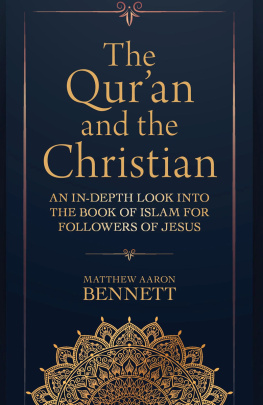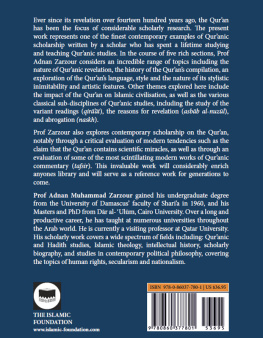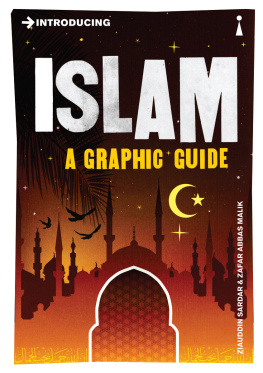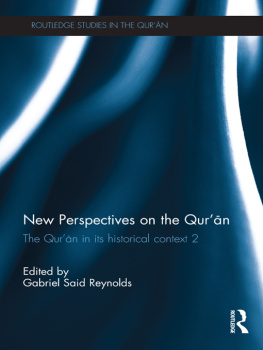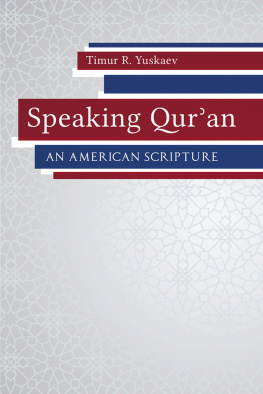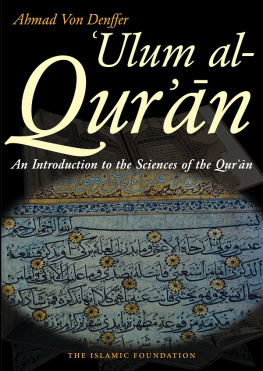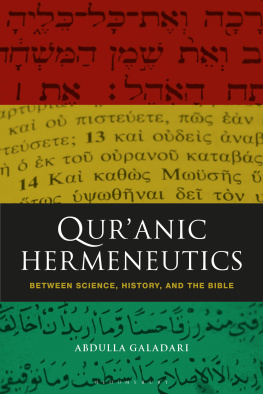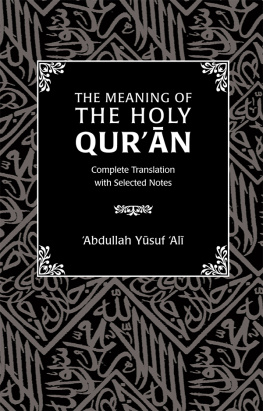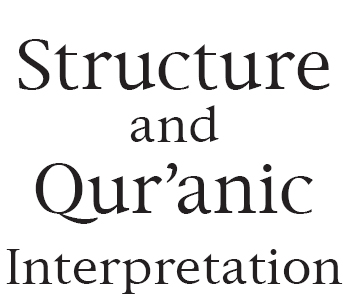


All rights reserved. Copyright 2014 by Raymond Farrin.
No part of this book may be reproduced or transmitted in any form or by any means whatsoever, including graphic, electronic, or mechanical, including photocopying, recording, taping, or by any information storage or retrieval system, without permission from the publisher.
White Cloud Press books may be purchased for educational, business, or sales promotional use. For information, please write: Special Market Department, White Cloud Press, PO Box 3400, Ashland, OR 97520
Website: www.whitecloudpress.com
Cover and Interior Design by C Book Services
First edition: 2014
14 15 16 17 18 10 9 8 7 6 5 4 3 2 1
Library of Congress Cataloging-in-Publication Data
Farrin, Raymond.
Structure and Quranic interpretation : a study of symmetry and coherence in Islams holy text / Raymond Farrin.
p. cm.
Includes bibliographical references and index.
ISBN 978-1-935952-99-2 (ebook.)
1. Quran--Hermeneutics. 2. Quran--Criticism, interpretation, etc. I. Title.
BP130.2.F377 2014
297.122601--dc23
2014017315
To Simon OMeara in memory of many stimulating conversations during evenings in Kuwait.
Contents

Acknowledgments

This book has been a project of numerous years, and during the process of researching, writing, and publishing it, I have been aided by many people. First, I wish to acknowledge the impetus provided by James Monroe of UC Berkeley. In early 2007, he indicated to me that the Qurans second chapter, The Cow, was arranged according to a concentric pattern, and he encouraged me to undertake a careful reading of it. His suggestion eventually led to my study, Surat al-Baqara: A Structural Analysis [The Muslim World 100 (2010): 17-32, by Blackwell Publishing], which appears in a revised form in the second chapter of this book.
Along the way, I have also benefited from the feedback of a number of scholars who read parts of this work or heard me present aspects of it at conferences and lectures. They are: Carl Ernst, Samer Ali, Dina Aburous, Martyn Smith, Sarra Tlili, Dalia Abo-Haggar, Gordon Newby, Alford Welch, Dan Ebert, Omer Abid, Carol Walker, Christian Lange, Afaf al-Bataineh, Asif Uddin, Nadia El Cheikh, Ramzi Baalbaki, and Bilal Orfali. And at the American University of Kuwait, I have been encouraged by various colleagues and students. In particular, I would like to mention my colleagues Mourad Dakhli, Christopher Gottschalk, Ildiko Kaposi, Christopher Ohan, Karim Jallad, Ali al-Jamal, Andrei Zavaliy, Abid Vali, Maher Tamimi, Emanuela Buscemi, and Khitam al-Khouli, and my students Nadia al-Essa, Esraa al-Shammari, Abdulrahman al-Farhan, Mefleh al-Mutairi, Abdulrahman Oqla, Saud al-Zaid, Maha al-Marii, and Fatima al-Adwani. The discussions I had with these people helped clarify many points. For any remaining lapses or oversights in the book, I bear responsibility.
I wish to extend my gratitude as well to Steve Scholl, Christy Collins, and the rest of the staff at White Cloud Press. Their excellent efforts helped bring out the finished product.
On a personal note, I would like to thank my brothers and sisters Jim, Jenny, Melody, and Jon, and especially my parents, for their great support and encouragement. Finally, I would like to recognize the assistance of my friend and colleague Simon OMeara. Throughout, he has offered suggestions, advice, and support.

The subject of the Qurans structure has attracted inquiry and stirred debate for a very long time. Study of the holy books form goes back at least as far as the Basran writer al-Jahiz (d. 255/868 or 869), who produced a work entitled The Composition of the Quran. And we are told that, in the fourth century AH/tenth century CE, a scholar named Abu Bakr al-Nisaburi would ask such questions as, Why is this verse next to this other one? and, What is the wisdom in the placement of this chapter next to this other one?; he would fault the Baghdad learned men of his day for their disregard of this type of questioning. A difference of opinion emerged on the question of the Qurans unity, and the subject became a matter for debate. Through subsequent centuries, numerous scholars produced additional works detailing the Qurans coherence, testifying to the fact that the case still needed to be made in these centuries and to the continued opposition to their thesis among some persons. The debate over structural integrity has continued into the modern period, during which it has intensified.
During the classical era, the Partisans of Coherence went to great lengths to show the interconnection of the Quran. Basically, their method came to involve three elements:
1) for any given chapter, pointing out the relationship of each successive verse to its predecessor
2) at the end of a chapter, highlighting the correspondence between the last verse and the opening one for that chapter
3) at the beginning of a new chapter, pointing out the connection between the first verse and the last one from the preceding chapter.
They sought in this way to bring to light the concatenation of the Quran. This approach has more recently been described as linear-atomistic, due to its focus on individual, successive verses, rather than on chapters as thematic units (lest we fault them for narrowness, however, we might recall, with Jonathan Culler, that the notion that the task of
Skeptics from the classical era, on the other hand, did not record much in the way of argument or evidence. One supposes they made judgments based on their impressions and left the matter at that. Perhaps, though, this statement by Ibn Abd al-Salam (d. 660/1262), commenting on the ways of those classical interpreters given to linking sequences of verses and chapters in relationships of meaning, may adequately summarize the skeptics position:
The science of correlations is a fine one, yet in order to demonstrate coherence it must be applied to speech that is unified, whose beginning connects to its end. If it is applied to speech uttered for various reasons, it does not disclose unity, and whoever tries to join the parts thereof tasks himself with what he cannot doexcept by means of tenuous links not found in good speech, to say nothing of the best. Verily, the Quran was revealed over a period of more than twenty years, gradually establishing and codifying different laws for various reasons, and what is revealed in this manner does not allow for the joining of all its parts.
We should note, though, that to the majority of Muslims who memorized and recited the Quran, this debate most likely seemed academic. The recited Quran is and has ever been the epitome of aesthetic as well as spiritual perfection for the faithful, observe William A. Graham and Navid Kermani; and what these people knew and experienced as perfection, the Word of God, did not need to be explicated structurally. Still, we suppose We suppose that this was the reaction of the majority upon listening to the Quran.
Next page

